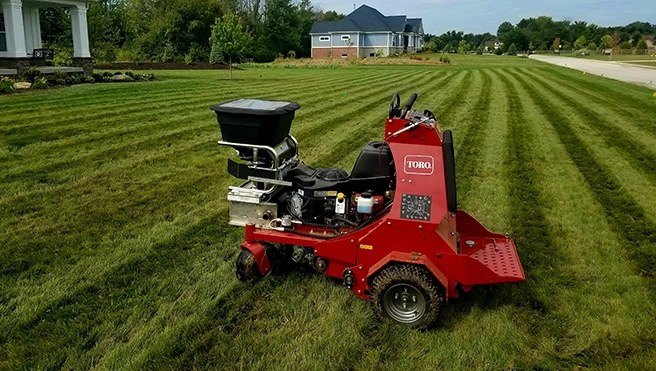Aeration
Because lawns need air, water, and food to grow, pulling plugs throughout the yard will help promote optimal grass growth. Our hydraulic core aerators pull small plugs from the soil and drop the plugs back onto the ground. These new holes break up the thatch layer and allow fresh air, water, and nutrients to easily penetrate the surface and reach deep down into the grassroots. This helps your grass grow deeper and stronger, which makes it thicker and healthier. Plugs that are dropped back onto the ground break down over time, supplying the lawn with more nutrients. Traditionally, aerating in the fall is recommended, as the aeration opens up the root zone, promoting new root growth and does not damage the pre-emergent layer that may have been applied in the spring, as a spring aeration would.
Aeration With Overseeding
Reseeding your lawn is an important step in proper lawn care maintenance. Just like all living things, your grass will not live forever. Most turf grasses that will produce seed, won’t produce viable seed until it is about twelve inches high. This is a problem for lawns that are mowed regularly. Reseeding your lawn also helps keep weeds out of your yard. Because weeds can only grow where there is room; you naturally can keep weeds at bay by lessening the opportunity for them to grow. With Lawn Pride’s Premium Turf Type Tall Fescue grass seed, you will have a stronger, more resilient lawn that is best for our Central Indiana environment. At Lawn Pride, we recommend having your lawn aerating and overseeding in the fall. Not only does the aeration opens up the root zone, promoting new root growth, but when aerating and overseeding in the spring means your newly seeded lawn would not be able to be treated for grassy weeds or broadleaf weeds leaving your new grass to compete for room to grow.
Understanding Is Half The Battle
Over time, the soil becomes more and more compacted. Several variables combine to cause this extreme compaction. Rain and snow, erosion, foot traffic, and root growth, as well as the natural breakdown of leaves, and grass clippings, all contribute to natural soil compaction. Since your lawn is a living organism, it needs food, water, and air in order for it to be healthy. Soil compaction acts like a clogged filter preventing the root system from getting the nutrients it needs.
If you are needing to seed your lawn, it’s crucial to aerate the lawn first to obtain good seed-to-soil contact for optimal germination. Aerating the soil, also allows for good gas exchange between the germinating seeds and the soil. Seeds, just like any other living organism need oxygen and produce carbon dioxide (CO2). If the carbon dioxide is not able to move away from the seed, the seed will suffocate.
Knowledgeable Staff
Our experienced and knowledgeable staff can answer any of your lawn care questions and provide you with helpful tips; so that together we can make your lawn look its best.



